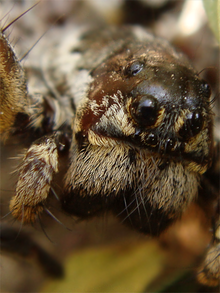Apulian tarantula
| Apulian tarantula | ||||||||||||
|---|---|---|---|---|---|---|---|---|---|---|---|---|

Apulian tarantula ( Lycosa tarantula ), female |
||||||||||||
| Systematics | ||||||||||||
|
||||||||||||
| Scientific name | ||||||||||||
| Lycosa tarantula | ||||||||||||
| ( Linnaeus , 1758) |
The Apulian tarantula ( Lycosa tarantula , syn .: Lycosa tarentula ) is a type of real spider from the genus Lycosa within the family of wolf spiders (Lycosidae). It is the type species of the genus. The name tarantula , the original name of the Apulian tarantula, is used today for a large number of spiders that are not closely related , including the tarantulas (Theraphosidae).
features
With a body length of 30 millimeters as a female and 25 millimeters as a male, the Apulian tarantula is one of the largest European wolf spiders. The basic color of the male is white-gray, that of the female is more yellowish. The front body is brown-gray with an indistinct, light longitudinal band and a light stripe underneath. On the back of the body there is a large longitudinal spot that has two spikes towards the end of the body. Behind it there are dark angular spots. These have a black cross band underneath, behind which they are bright yellow. The legs are spotted in a very contrasting black and white underneath and uniformly gray-brown on the upper side.
Occurrence
The Apulian tarantula is widespread in the western Mediterranean area , especially in central and southern Italy , as indicated by the German-speaking name after the Italian region of Apulia . It prefers dry and stony places with little vegetation. The density of individuals is usually low.
Way of life
The Apulian tarantula lives mostly hidden in a self-dug 30 cm deep and thumb-thick tube. This leads vertically down into the ground and is lined on the inside with a fine woven ceiling. At the mouth of the housing tube, blades of grass and other parts of the vegetation are spun together to form a collar. This collar often towers above the surrounding area. The spider usually sits deep in the tube, but likes to sit in the opening of the tube in spring to sunbathe. Likewise, during the spring, the males run around looking for females during the day. After mating, the female builds an egg cocoon . This is white and contains a few hundred eggs. The female often holds it inside the tube with the tip of the abdomen towards the warming rays of the sun.
Tarantism
The Apulian tarantula is associated in a special way with the medical phenomenon of tarantism . It is the actual tarantula, the name of which is derived from the Apulian city of Taranto ( Táranto in Italian ). The bite of the spider, along with the sting of the scorpion, was considered to be the cause of the disease, which manifested itself in hysterical fits of dancing rage to complete exhaustion. The folk dance Tarantella should be able to simulate the symptoms as well as lead to their healing. Today tarantism is viewed as a mental illness in connection with mass suggestion, an actual connection with this or any other spider species is considered unlikely.
Web links
Lycosa tarantula in the World Spider Catalog
- Lycosa tarantula in Fauna Europaea
literature
- Heiko Bellmann: The cosmos spider guide. Over 400 species in Europe. Franckh-Kosmos, Stuttgart 2010, p. 180, ISBN 978-3-440-10114-8 (= Kosmos nature guide ).
- Carl von Linné : Systema naturae per regna tria naturae, secundum classes, ordines, genera, species cum characteribus differentiis, synonymis, locis. Editio decima, reformata. Araneae, pp. 619-624, Stockholm 1758 (first description).
Individual evidence
- ↑ Natural History Museum of the Burgergemeinde Bern: World Spider Catalog Version 17.0 - Lycosa tarantula . Retrieved April 25, 2016.
- ^ Jean Foro Russell (1979): Tarantism. Medical History 23: 404-435.



